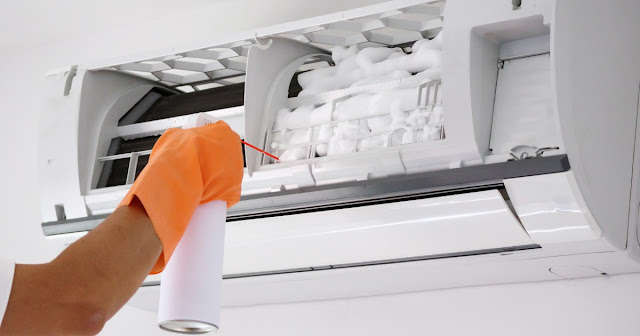When it comes to HVAC performance and energy efficiency, coil cleaning isn’t just a nice-to-have — it’s essential. Dust, grime, mold, and debris can build up on your air conditioner's coils over time, drastically reducing efficiency and potentially leading to costly repairs or system failure. That’s where professional coil cleaning makes all the difference.
In this article, we’ll walk you through exactly what to expect during a professional coil cleaning, how it helps your system run better, and why homeowners and businesses alike trust AC Coil Cleaning for this critical maintenance task.
Why Coil Cleaning Matters
Air conditioners have two main types of coils:
-
Evaporator Coils (indoor)
-
Condenser Coils (outdoor)
These coils are essential for heat exchange: the evaporator coils absorb heat from inside your home, while the condenser coils expel that heat to the outside. When they get dirty, they restrict airflow and force your system to work harder, consuming more energy and wearing out faster.
“A dirty AC coil can cause your system to use up to 30% more energy.”
What Happens During a Professional Coil Cleaning?
Professional coil cleaning is a structured process. Technicians follow a proven sequence to ensure your system is restored to optimal performance. Here's a detailed breakdown:
1. Initial System Inspection
The technician begins with a visual inspection of your HVAC system, noting any signs of wear, corrosion, blockages, or performance issues. They’ll check:
-
Indoor and outdoor units
-
Coil condition
-
Airflow restrictions
-
Refrigerant lines
-
Signs of mold, mildew, or biofilm
This assessment allows them to gauge how thorough the cleaning needs to be.
2. System Shutdown and Safety Prep
For safety and thoroughness, the technician will power down the system. They may disconnect electricity and refrigerant lines if necessary. This ensures:
-
Technician safety
-
Prevention of short-circuiting
-
No damage to internal components
Protective covers and drop cloths are used to keep the surrounding area clean.
3. Accessing the Coils
Accessing the coils depends on your unit type (central, mini-split, or window unit). Technicians will:
-
Remove outer panels
-
Detach fan units if needed
-
Carefully access the evaporator and condenser coils
In some cases, filters and surrounding parts may also be removed for better access.
4. Coil Cleaning Methods Used
The technician will determine the best cleaning method based on the coil type and level of contamination. The table below outlines the most commonly used coil cleaning methods:
| Cleaning Method | Best For | How It Works |
|---|---|---|
| Foam Coil Cleaner | Light dirt, indoor coils | Sprayed on; foam expands and loosens debris |
| Compressed Air | Dry dust, delicate coils | Air jets blow off surface-level particles |
| Brush Cleaning | Surface buildup | Soft brushes manually remove stuck dirt |
| Pressure Washing | Outdoor condenser coils | Water at controlled pressure washes away gunk |
| Chemical Cleaning | Heavy grime, mold | Specialized solutions dissolve contaminants |
In severe cases, AC Coil Cleaning technicians may also apply anti-microbial treatments to inhibit future growth of mold and mildew.
5. Rinse and Dry
After applying the cleaning method, technicians will thoroughly rinse and dry the coils (unless using no-rinse foams). This prevents moisture buildup and protects other components from corrosion.
6. Reassembly and System Testing
Once the coils are clean and dry:
-
All panels and components are reinstalled
-
The system is reconnected and powered on
-
A full test cycle is run to confirm airflow and temperature
-
Air filters may be replaced if needed
Our AC Coil Cleaning team also verifies refrigerant pressure, thermostat operation, and checks for unusual noises or vibrations.
Benefits You’ll Notice Immediately
Once your coils are professionally cleaned, you'll likely experience:
-
Faster cooling or heating
-
Lower energy bills
-
Improved indoor air quality
-
Longer lifespan of your AC unit
-
Less wear and tear on system components
It’s more than just a cleaning—it’s a smart investment in long-term comfort and system reliability.
Why Choose AC Coil Cleaning?
At AC Coil Cleaning, we specialize in one thing and do it better than anyone else: coils. We’re not just HVAC generalists — our certified technicians are coil care experts with years of experience and industry-standard tools.We provide expert services for both residential and commercial HVAC systems throughout the area.
With every service, we include:
-
Full coil inspection
-
Customized cleaning based on coil type
-
Free airflow & efficiency test
-
Optional UV/mold protection treatment
-
Transparent pricing with no upsells
FAQs About Professional Coil Cleaning
Q: How frequently should AC coils be cleaned?
A: At least once a year is ideal, especially before summer. More frequent cleaning may be needed for dusty environments or commercial systems.
Q: Is coil cleaning safe for my AC?
A: Absolutely — when done professionally. DIY cleaning can risk bending fins or damaging components. Professionals use the right tools and techniques to avoid harm.
Q: How long does a professional coil cleaning take?
A: Typically 1–2 hours, depending on system access and dirt buildup. Severe contamination may require longer.
Q: Does it improve air quality?
A: Yes. Clean coils reduce mold, mildew, and allergens in your air, especially when paired with new filters.
Q: What’s the cost of coil cleaning?
A: Prices vary by unit type and condition but typically range from $100 to $300. Preventative cleaning is always cheaper than major repairs or replacements.
Final Thoughts
Professional coil cleaning might not be glamorous, but it’s one of the smartest things you can do to keep your HVAC system running like new. With AC Coil Cleaning, you’re not just getting clean coils — you’re getting peace of mind, better air, and lower energy bills.
So the next time your AC starts feeling sluggish or your energy bills spike, remember: Clean coils = cool comfort.
Trust AC Coil Cleaning — your coil, our care.
Read More: Thornton Airduct Cleaning





0 Comments